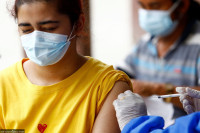Health
Nepal drugs regulator bans 103 antibiotic combinations
Of the 103 combos, 14 are being used in Nepal. Irrational use of combinations is fuelling antibiotic resistance.
Arjun Poudel
The Department of Drug Administration has banned the use of 103 combinations of antibiotics, which are not recommended by the World Health Organisation.
The move of the department, the national drugs regulator, aims to reduce antibiotic resistance, which is alarmingly high in the country.
“We have not restricted the use of any individual antibiotics. Only the use of combinations of two or more antibiotics is prohibited,” said Narayan Dhakal, director general of the department. “Combination antibiotics are being used widely in many countries including in Nepal and studies show irrational use of combination antibiotics increases antibiotics resistance.”
Of the 103 combinations, whose list the department published on Sunday, 14 are in use in Nepal.
According to the Department amoxicillin/cloxacillin, ampicillin/cloxacillin, ampicillin/dicloxacillin, benzylpenicillin/streptomycin, cefepime/sulbactam, cefixime/clavulanic acid, cefoperazone/sulbactam, cefotaxime/sulbactam, ceftriaxone/sulbactam, ceftriaxone/tazobactam, cefuroxime axetil/clavulanic acid and ofloxacin/imidazole are being used in Nepal.
Antimicrobial resistance has emerged as a worldwide concern due to the acute health threat posed by antibiotic-resistant pathogens. The World Health Organisation said antimicrobial resistance occurs when bacteria, viruses, fungi and parasites change over time and no longer respond to medicines, making infections harder to treat and increasing the risk of disease spread, severe illness and death. As a result, the medicines become ineffective and infections persist in the body, increasing the risk of spreading to others.
While human antibiotic use contributes to antibiotic resistance, the widespread use of antibiotics in agricultural applications—most notably livestock and poultry production—is also a potential driver.
“The UN health body after research in many of its member countries about antibiotics resistance had published the list of non-recommended antibiotics in 2021 to discourage their use,” said Dhakal. “Our decision to enforce restrictions on use, manufacturing, importing and supplying of the drugs on the list is in line with the recommendations of the WHO and our own drug advisory committee.”
Although antibiotics are prescription drugs, they can be easily purchased over the counter in Nepal. Many people buy these drugs without telling the pharmacists their exact problem. Pharmacists too do not bother to inquire and in most cases fail to emphasise the importance of completing the course of medicine.
Doctors too often prescribe antibiotics on the basis of clinical diagnosis, even before they get laboratory test reports. Experts say antibiotics do not work if the underlying infection is caused by a virus.
According to a study carried out by the Nepal Health Research Council, about 85 percent of the doctors in Nepal do not prescribe antibiotics to patients by their generic name, meaning that most of the antibiotics are prescribed by their brand names.
Nepal doesn’t have a mandatory policy that medicines, including antibiotics, should be prescribed by their generic names.
As per the report, only 32 percent of the doctors and health workers have access to laboratories for antibiotic susceptibility testing. Among them, only 49 percent recommend antibiotic susceptibility testing before prescribing antibiotics. This means that only 16 percent of doctors recommend antibiotics after conducting susceptibility testing.
Public health experts warn that antibiotics, which have saved millions of lives throughout the world, could soon become ineffective due to the high resistance rate caused by their irrational use.
A lot of Nepali patients countrywide have been affected by antimicrobial resistance.
The report showed that 41 percent of the doctors and health workers had not heard of a national guideline for antibiotics prescriptions. Among the around 59 percent of those who had heard about the national guideline for antibiotics prescriptions, only 54 percent had access to it.
“We have directed our drug inspectors to monitor if the manufacturing companies have recalled the said drugs from the market or not,” said Dhakal. “We will also stop registering, renewing, and giving import approval of the said medicines to stop its use.”




 13.12°C Kathmandu
13.12°C Kathmandu














